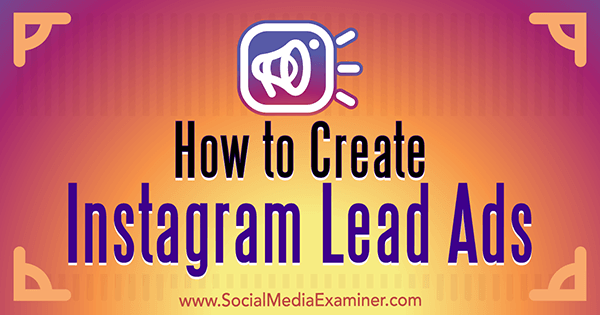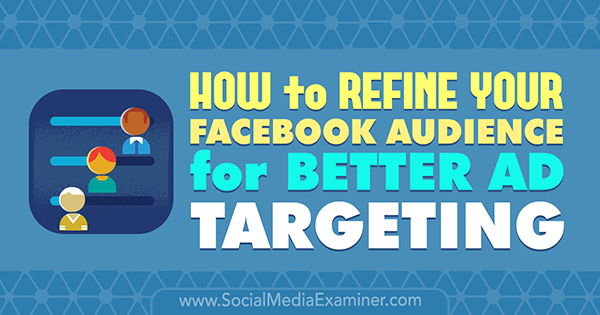

Want more leads?
Instagram lead ads let you collect valuable contact information from potential customers without pushing them off of the platform.
In this article, you'll discover how to set up lead ads on Instagram.
 How to Create Instagram Lead Ads by Deirdre Kelly on Social Media Examiner.
How to Create Instagram Lead Ads by Deirdre Kelly on Social Media Examiner.To get started with lead ads, create a new ad campaign and select Lead Generation as the objective.
 Choose the Lead Generation objective at the campaign level.
Choose the Lead Generation objective at the campaign level.Next, continue to ad set level to define your audience targeting. If you have existing lead/customer data, always use a lookalike audience. Upload your customer list to use as the source audience to build your lookalike audience.
 Define audience targeting for your Instagram lead ad.
Define audience targeting for your Instagram lead ad.Using your customer list as the source audience will give you better results than simply using existing leads from previous marketing efforts, which include people who have yet to drive any real value for your business. People who've actually spent money with your business (rather than just signaled interest) provide much stronger data for Facebook to work with.
It's even better if your customer base is large enough to segment out a portion of higher-value customers (e.g., repeat purchasers, high-spend purchasers, premium subscribers, etc.) to use as your lookalike source. Remember, though, Facebook recommends using a source audience of at least 1,000 users for best results.
Always exclude existing leads so you're not wasting impressions and ad dollars. By continuously retargeting the same users, you can stimulate negative feedback, which will deflate your relevance score and hurt your CPMs (cost per thousand impressions).
Facebook now lets you create an audience of users who successfully opened and submitted a lead form, so you can dynamically exclude incoming leads. With all other leads, you'll have to manually upload data to Facebook before excluding people.
 Create a custom engagement audience in Facebook Audience Manager.
Create a custom engagement audience in Facebook Audience Manager.Under Placements, select the Automatic Placements option, because that only includes the Facebook news feed and Instagram anyway. Audience network and all other Facebook placements are ineligible.
 Choose the placements where you'd like your lead ads to be served.
Choose the placements where you'd like your lead ads to be served.Although lead ads were originally rolled out just for mobile, Facebook realized that advertisers face all of the same obstacles on desktop too. Users are impatient, and making the process easier (by letting users submit their info in just a few taps) benefits both parties regardless of device. By selecting auto placement, your ads will be delivered on both desktop and mobile.
In your bidding, make sure you optimize for leads vs. link clicks. Link clicks may result in a higher click-through rate but you should always optimize for what your true goal is, which is simply leads in this case.
 Optimize your Instagram ad for leads.
Optimize your Instagram ad for leads.Now you're ready to move to the ad level. The front end of the ad unit is the standard format for regular ads, with the same creative options available.

A carousel ad that highlights the benefits of your service or product features/use cases can work nicely here. Incorporating testimonials and reviews is also a good idea. Although video works well, a slideshow can be an easier, cheaper alternative and Facebook provides simple tools for creating one.
 Here's the carousel ad format used with Instagram lead ads.
Here's the carousel ad format used with Instagram lead ads.It's finally time to create your lead form! You should be thinking quality over quantity here.
To make sure your leads are qualified, always use a context card. The context card appears after users click on the ad and before they submit their information. This is where you lay out the benefits of submitting the form to your prospects. You can choose a paragraph or bullet point format for this card.
The following example uses bullet points to relay the main selling points to potential leads.
 Spell out the benefits of your product or service on the context card for your Instagram ad.
Spell out the benefits of your product or service on the context card for your Instagram ad.Keep questions to a minimum; less is more in this case. The user information fields, which consist of primary contact info along with some basic demographic and work information, will pre-fill with users' personal details as long as they've included them in their Facebook profile. This makes it easy for users to submit this information.
However, be careful not to include fields that aren't necessary, because users might be reluctant to hand over too much personal information this early in the relationship.
You can add up to three custom questions, but use these sparingly. If possible, ask multiple choice questions rather than open-ended questions. The more convenient the process, the more conversions you'll achieve.
 Customize the fields and questions on your Instagram lead form.
Customize the fields and questions on your Instagram lead form.If you're collecting customer information, you should already have a written privacy policy. Hopefully, it's posted on your website so you can provide a link to your privacy policy. This is a required field for creating the lead form.
Lastly, you can add a link to your website that users will see on the thank-you page along with a View Website call-to-action.
 The thank-you page of your Instagram lead ad includes a link to your website.
The thank-you page of your Instagram lead ad includes a link to your website.Conclusion
As Facebook's mobile ad inventory skyrockets, the platform is determined to make it easier for advertisers to generate value from mobile users. Introducing Instagram placement for lead ads is the latest example of this.
To get the most out of the leads you generate, make sure you follow up with them in a timely fashion. If you have a customer relationship management (CRM) system in place, you can set up your leads to sync automatically, so you can follow up as quickly as possible when the leads are most valuable. Manually downloading leads can result in a long lag between receiving a lead and following up with a prospect.
Facebook already supports many of the most popular CRM systems like Salesforce, MailChimp, and Zapier. You can find more information on the available integrations here. If you don't see yours listed, it might take some work by your developer to set up lead syncing through the Facebook API. Alternatively, you could use a middleman integration like LeadsBridge.

What do you think? Will you try Instagram lead ads? Please share your thoughts in the comments below.
 How to Create Instagram Lead Ads by Deirdre Kelly on Social Media Examiner.
How to Create Instagram Lead Ads by Deirdre Kelly on Social Media Examiner. View the original article here
Original source: How to Create Instagram Lead Ads.
http://www.jretechnology.com





 5 Ways to Use Facebook Messenger Bots for Your Business by Ana Gotter on Social Media Examiner.
5 Ways to Use Facebook Messenger Bots for Your Business by Ana Gotter on Social Media Examiner. You can build c hatbots for a variety of purposes, including customer service and content marketing.
You can build c hatbots for a variety of purposes, including customer service and content marketing. The Whole Foods chatbot offers value through content rather than selling directly to users.
The Whole Foods chatbot offers value through content rather than selling directly to users. Sending users to your website from a chatbot can get you more traffic and potentially more sales.
Sending users to your website from a chatbot can get you more traffic and potentially more sales. Including browsing menus in your chatbot makes it easier for users to find the information they're looking for.
Including browsing menus in your chatbot makes it easier for users to find the information they're looking for. The Domino's chatbot makes it easy for customers to track their order. This can cut down on calls to the store.
The Domino's chatbot makes it easy for customers to track their order. This can cut down on calls to the store. 1-800-Flowers gives customers the option to connect with a live agent, who can offer personalized help.Let users know up front that they're working with an automated response system. You can't trick peop le into thinking they're talking to a real person, especially when it comes to customer service issues.If you need personal information to verify a user's identity, direct that person to customer service via your website or a phone number. Asking for this information via Facebook Messenger is normally not a good idea for security reasons.
1-800-Flowers gives customers the option to connect with a live agent, who can offer personalized help.Let users know up front that they're working with an automated response system. You can't trick peop le into thinking they're talking to a real person, especially when it comes to customer service issues.If you need personal information to verify a user's identity, direct that person to customer service via your website or a phone number. Asking for this information via Facebook Messenger is normally not a good idea for security reasons.
 Customers can easily browse and select products from the 1-800-Flowers chatbot.
Customers can easily browse and select products from the 1-800-Flowers chatbot. Not only can customers select prod ucts, but they can also schedule delivery and enter billing information through the 1-800-Flowers chatbot.
Not only can customers select prod ucts, but they can also schedule delivery and enter billing information through the 1-800-Flowers chatbot. Trivia Blast's chatbot focuses on trivia games users can play, but also maintains a high level of interaction with options like "challenge friends" and "watch how it works."
Trivia Blast's chatbot focuses on trivia games users can play, but also maintains a high level of interaction with options like "challenge friends" and "watch how it works." Offering automated services through a chatbot can boost business.
Offering automated services through a chatbot can boost business. Botsify has a user-friendly interface.
Botsify has a user-friendly interface. Converse's chatbot builder is a little more difficult to navigate but the tool offers fantastic customer service and features.
Converse's chatbot builder is a little more difficult to navigate but the tool offers fantastic customer service and features. Chatfuel's bot builder is easy to use, and they offer a 10-minute tutorial to take you through the creation process.
Chatfuel's bot builder is easy to use, and they offer a 10-minute tutorial to take you through the creation process.
 5 Ways t o Use Facebook Messenger Bots for Your Business by Ana Gotter on Social Media Examiner.
5 Ways t o Use Facebook Messenger Bots for Your Business by Ana Gotter on Social Media Examiner. 
 How to Refine Your Facebook Audience for Better Ad Targeting by Deirdre Kelly on Social Media Examiner.
How to Refine Your Facebook Audience for Better Ad Targeting by Deirdre Kelly on Social Media Examiner. Choose how you want to create your Facebook custom audience.
Choose how you want to create your Facebook custom audience. Create a Facebook custom audience using a customer list.
Create a Facebook custom audience using a customer list. Choose how you want to upload customer information to create your Facebook custom audience.
Choose how you want to upload customer information to create your Facebook custom audience. When creating a Facebook custom audience from your email list, you can improve your match rate with additional identifiers.
When creating a Facebook custom audience from your email list, you can improve your match rate with additional identifiers. Create a Facebook custom audience based on website traffic.
Create a Facebook custom audience based on website traffic. From the Website Traffic menu, choose whom you want to include in your Facebook custom audience.
From the Website Traffic menu, choose whom you want to include in your Facebook custom audience. Create a Facebook custom audience of people who spend the most time on your website.
Create a Facebook custom audience of people who spend the most time on your website. Build a Facebook custom audience of people who visit specific pages of your site.
Build a Facebook custom audience of people who visit specific pages of your site.
 Set up a Facebook custom audience based on a defined purchase behavior.
Set up a Facebook custom audience based on a defined purchase behavior. You can create a Facebook custom audience of customers with a higher AOV.
You can create a Facebook custom audience of customers with a higher AOV. Use a Facebook custom audience to create a winback campaign for dormant customers/visitors.
Use a Facebook custom audience to create a winback campaign for dormant customers/visitors. Select Engagement on Facebook to set up your Facebook custom audience.
Select Engagement on Facebook to set up your Facebook custom audience. Choose Page to create your Facebook custom audience.
Choose Page to create your Facebook custom audience. Create a custom audience of people who have interacted with your business on Facebook.
Create a custom audience of people who have interacted with your business on Facebook. Gain insights into your Facebook custom audience by looking at the different data graphs available.
Gain insights into your Facebook custom audience by looking at the different data graphs available. View a breakdown of Facebook custom audience demographics.
View a breakdown of Facebook custom audience demographics.
 How to Refine Your Facebook Audience for Better Ad Targeting by Deirdre Kelly on Social Media Examiner.
How to Refine Your Facebook Audience for Better Ad Targeting by Deirdre Kelly on Social Media Examiner.